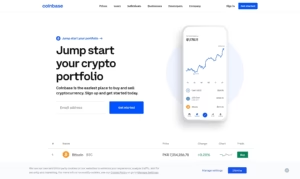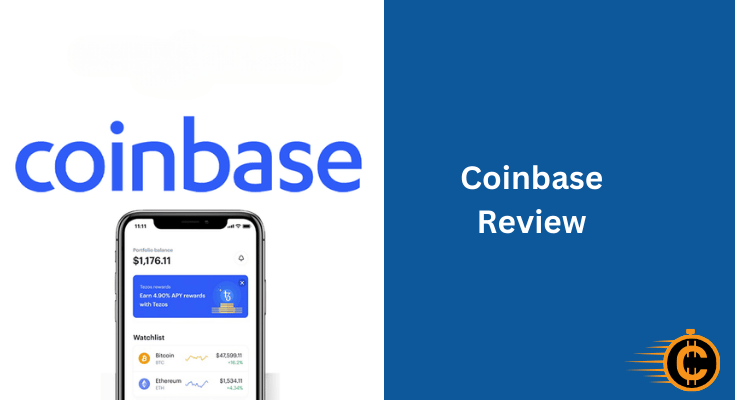Coinbase is one of the most recognized cryptocurrency exchanges in the world, offering a user-friendly interface and a wide selection of digital assets. Designed to serve both beginners and experienced traders, Coinbase has grown into a comprehensive crypto ecosystem. This article explores the platform’s pros and cons, features, registration and trading processes, and alternatives, providing a thorough look at what to expect when using Coinbase in 2025.
What Is Coinbase?
Coinbase is a leading cryptocurrency exchange headquartered in the United States. Founded in 2012, it provides a platform for buying, selling, and managing digital currencies like Bitcoin, Ethereum, and many others. Coinbase is known for its regulatory compliance, ease of use, and integration with traditional financial systems, making it a go-to platform for millions of users globally.

Pros
- User-Friendly Interface: Ideal for beginners with intuitive navigation and a clean design.
- Regulatory Compliance: Registered with FinCEN and licensed in multiple jurisdictions.
- Wide Range of Cryptocurrencies: Supports over 250 digital assets as of 2025.
- High Liquidity: One of the largest trading volumes in the U.S. market ensures minimal slippage.
- Secure Storage: Majority of user funds are stored in cold wallets, with insurance on custodial assets.
- Mobile App: Available for iOS and Android with full trading and wallet functionality.
Cons
- Higher Fees: Trading fees can be more expensive compared to other platforms, especially for beginners using the standard platform.
- Limited Altcoin Selection in Some Regions: Certain tokens are unavailable due to local regulations.
- Customer Support Delays: Despite improvements, some users report slow responses during high-traffic periods.
- No Anonymous Trading: Full KYC is required, which may deter privacy-focused users.
Features of Coinbase
Coinbase offers a robust suite of features, including:
- Coinbase Wallet: A non-custodial wallet that allows users to store, send, and receive crypto securely.
- Coinbase Pro (Now Coinbase Advanced): An advanced trading interface with lower fees and real-time charting tools.
- Staking Rewards: Users can earn yield on supported cryptocurrencies like ETH, ADA, and SOL.
- Recurring Buys: Automatically schedule crypto purchases on a daily, weekly, or monthly basis.
- Educational Rewards: Learn-to-earn campaigns offering crypto incentives for completing lessons.
How to Open an Account at Coinbase
Opening an account at Coinbase is straightforward:
- Visit www.coinbase.com.
- Click Get Started and enter your personal details (name, email, password).
- Agree to the terms and conditions and verify your email.
- Complete identity verification (KYC).
Coinbase Registration and KYC Process
Coinbase complies with strict regulatory standards. The Know Your Customer (KYC) process includes:
- Uploading a government-issued ID (passport, driver’s license, or national ID).
- Verifying your identity through a real-time selfie or webcam verification.
- Providing proof of address (utility bill or bank statement).
Most verifications are completed within a few minutes to 24 hours, depending on the volume of new applicants.
How to Deposit Funds at Coinbase
Coinbase supports various funding methods based on your region:
- Bank Transfer (ACH/SEPA): Free but may take 1–3 business days.
- Debit Card: Instant deposits, though fees may apply.
- Wire Transfer: Suitable for large transactions.
- Crypto Deposits: Instantly credited after sufficient network confirmations.
Depositing is as simple as linking a payment method from the Payments section and choosing the amount to deposit.
How to Trade on Coinbase
Coinbase offers both basic and advanced trading options.
Basic Trading:
- Select the cryptocurrency you want to buy/sell.
- Enter the amount and choose a payment method.
- Confirm the order.
Advanced Trading (via Coinbase Advanced):
- Navigate to the trading dashboard.
- Use limit, market, or stop orders.
- Utilize charting tools for technical analysis.
- Execute trades with lower fees.
How to Withdraw from Coinbase
Withdrawals can be made to both fiat accounts and external wallets.
To withdraw fiat:
- Go to Assets > Withdraw.
- Choose the fiat currency and method (bank, PayPal, wire).
- Enter the amount and confirm.
To withdraw crypto:
- Select the crypto you want to send.
- Enter the recipient wallet address and network.
- Confirm the transaction.
Withdrawal processing times vary from instant (crypto) to 1–3 business days (fiat).
Coinbase Alternatives
While Coinbase is a reliable platform, several alternatives may better suit specific needs:
- Kraken: Lower fees, strong security, and advanced trading tools.
- Binance.US: Offers more altcoins and lower trading costs, but with a more complex interface.
- Gemini: Focuses on regulatory compliance and institutional-grade security.
- Crypto.com: Known for its cashback cards and broad crypto ecosystem.
- Robinhood Crypto: Good for beginners, especially those already using Robinhood for stock trading, though limited in crypto features.
Conclusion
Coinbase remains one of the best options for individuals entering the world of cryptocurrency. Its ease of use, regulatory transparency, and wide range of supported coins make it a reliable platform for everyday investors and crypto enthusiasts alike. However, higher fees and limited advanced features in some areas may prompt users to explore alternatives.
FAQ
Is Coinbase safe to use?
Yes. Coinbase employs high-security standards, including cold storage, 2FA, and insurance for custodial assets.
What are the trading fees on Coinbase?
Fees vary depending on trade size and platform usage. Standard Coinbase fees range from 0.5% to 1.5%. Coinbase Advanced offers lower rates starting from 0.60% maker/taker.
Can I use Coinbase without verifying my identity?
No. Full KYC is required to comply with financial regulations.
Does Coinbase support staking?
Yes, staking is available for several tokens, including Ethereum, Solana, and Tezos.
Is Coinbase available worldwide?
Coinbase is available in over 100 countries, though features may vary based on location.

